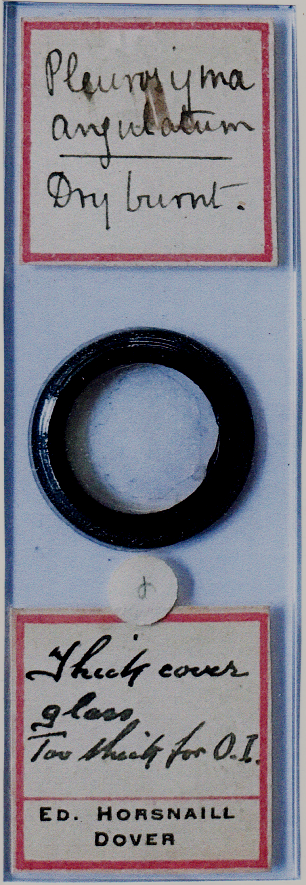
ED HORSNAILL OF KENT: NOTES ON HIS MATERIAL, HIS CONNECTIONS AND POSSIBLE SOURCES
Peter B. Paisley, Sydney, Australia
Ed Horsnaill the Kent mounter is commonly thought to have focussed on east Kent coastal material near his homes in Dover and Folkestone. He seems not to have sold mounts (I see no retail stickers on his work); his living came from his family upholstery business, and his mounts rarely turn up at auction. Brian Stevenson has written a useful biography (see www.microscopist.net): in all, it shows nine mounts, mostly coastal material, and his bibliography suggests little geographical range for sample collecting.
It would of course be unusual if a keen amateur and enthusiastic member of local microscopical societies, whatever his fixity of abode, never ventured beyond narrow choices of material. For instance, just about everybody had an interest in diatoms, and Horsnaill indeed prepared some, witness the mount below.

This may be an early effort, or even unique – as the owner’s label notes, the cover glass was too thick for proper visualisation.
If we assume – as seems reasonable – that Horsnaill’s papered mounts are earlier than his non-papered, then the three insect mounts below probably indicate that he prepared insects throughout his career, sometimes with detailed labels.
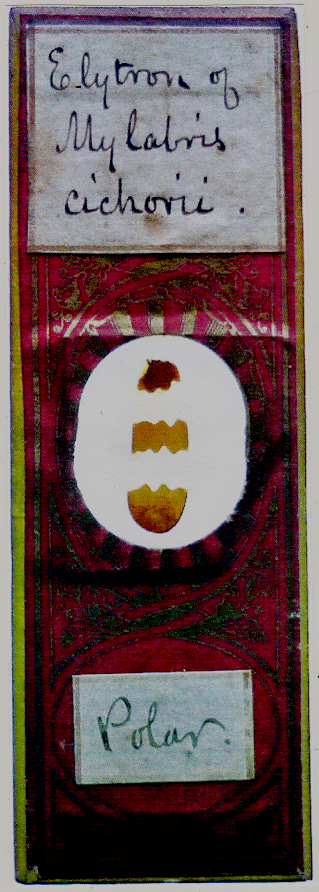
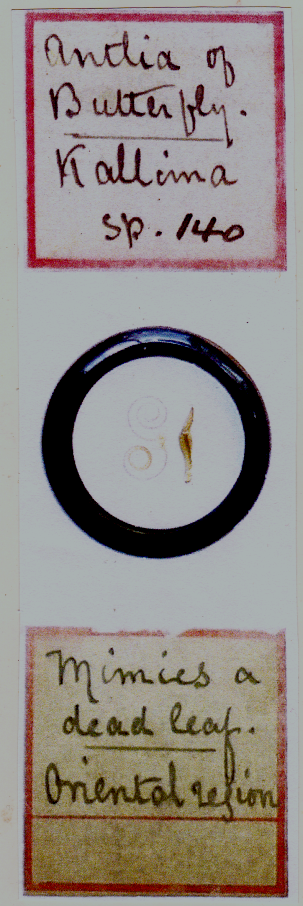
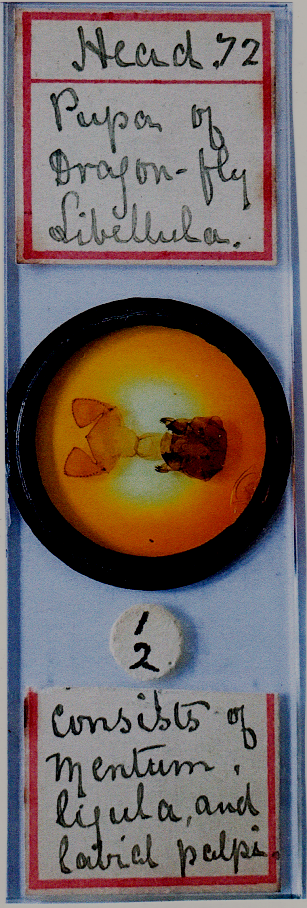
Probable early (L) and late Horsnaill insect preparations
Often, nineteenth century mounters envisaged spiders under the aegis of “insects”: Horsnaill may or may not have done so – but whatever the case, he certainly mounted them. However, as in the example below, he could be uncertain on taxonomy.
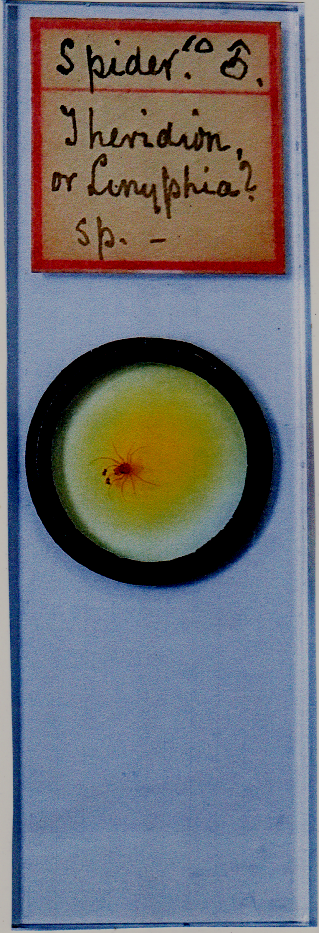
Horsnaill knew this spider was male, but was unsure of its species
Horsnaill might have visited the Giant’s Causeway in Ulster (Brian Stevenson’s article shows a mount of Giant’s Causeway basalt): but as Dr. Johnson remarked, that was worth seeing but not worth going to see, and if he sought zeeolite (a popular choice) for a rock section, he could have obtained it, with basalt, by post from someone in the Belfast Naturalists’ Field Club, who visited the causeway on excursions. Some say he mounted such minerals only late in his career: but, Dover being an important port, he could always have obtained samples from abroad through contacts in the shipping business. Four shown below were made before he left Dover for Folkestone, suggesting he developed the necessary skills early in his career, and in one case immediately below, he was able to obtain material locally, despite its distant origin, since it came from road works, I assume in and/or around Dover.
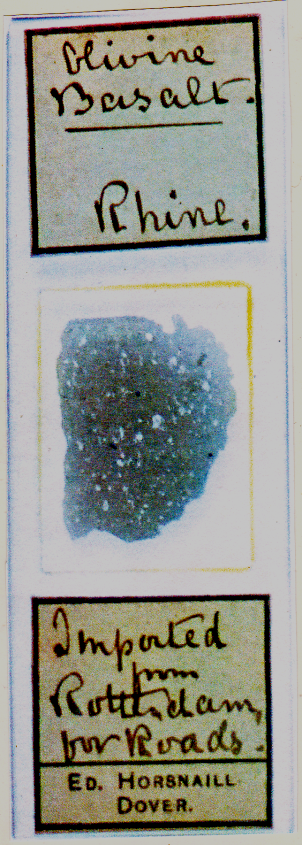
The next three mounts are interesting, in more ways than one.
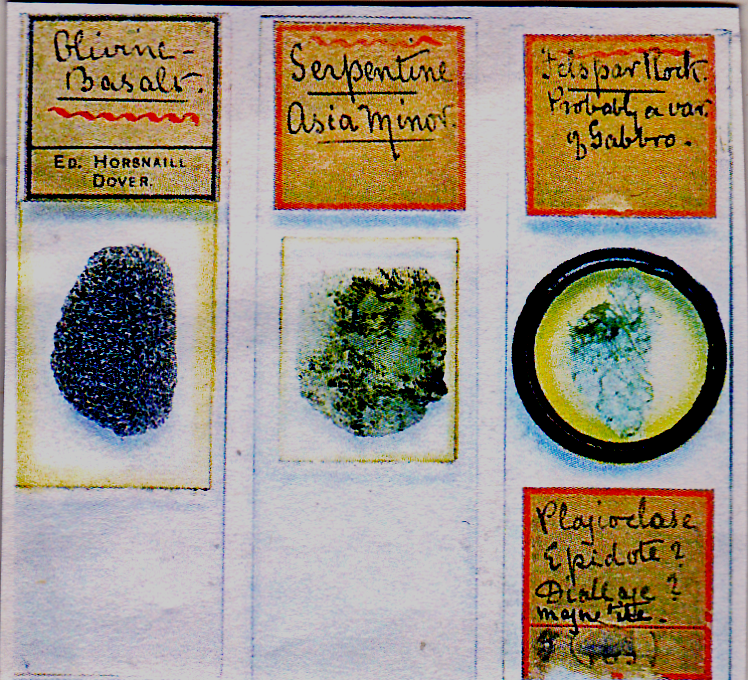
Above, three more Horsnaill rock sections: the duplicate Rhine basalt, and the other materials, prove he was skilled at cutting thin rock slices, but also hint he may have occasionally sold his work, perhaps through local chemists or opticians in Dover. On balance, I think he probably intended such duplicates for use as exchanges – in the absence of retail stickers on his known mounts, that seems more likely. The feldspar mount is ringed, like others already shown in this article, so he had a ringing table.
His interests extended to animal histology, as the slide below shows.
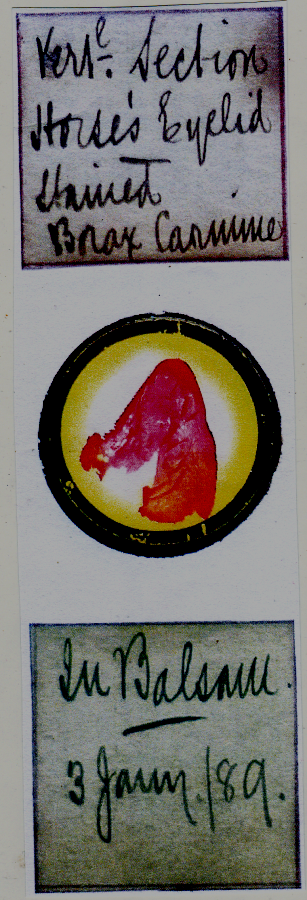
This horse eyelid mount is dated, which is rare – usually one has to guess.
Local marine specimens were common choices, but he could have gone to north Kent by train and collected from the Thames estuary outflow, which might explain the vaguely labelled “British seas” polyzoan shown in the Stevenson article. But: one might not expect to find deep ocean soundings among Horsnaill’s mounts.
My own collection contradicts that impression, as the examples below illustrate.
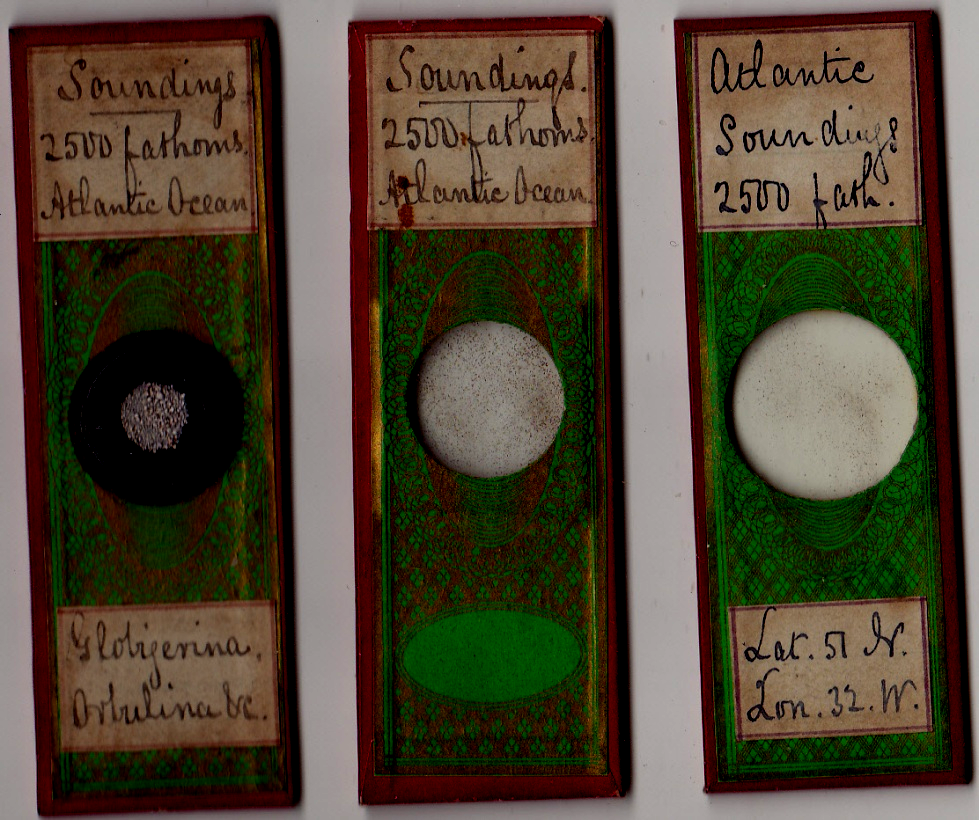
From the depths quoted, and the papered style, they may well date from the Challenger expedition. The handwriting is Horsnaill’s: he does not attach personal identifying labels (as often as not, true of his mounts). Certainly, Challenger material was mounted by a huge number of UK preparers, at first perhaps from material on-sold by the Norman firm (who initially claimed sole rights but probably could not enforce them). The well known Microscopical Mounts and Mounters shows one Horsnaill mount:
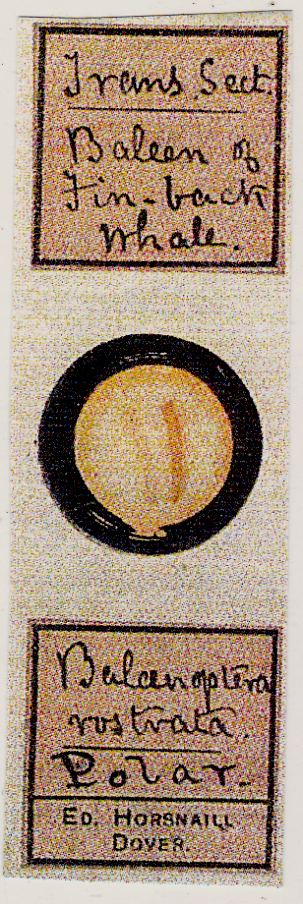
From Plate 20 R in MM&M
That baleen mount is from around 1903, when Horsnaill was still in Dover - which says nothing on when he actually got the sample, and I think it’s also Challenger material. Micscape readers familiar with microscopical ocean sampling may not expect to see mounts like that – still less might they expect to encounter a record such as that shown next, below.
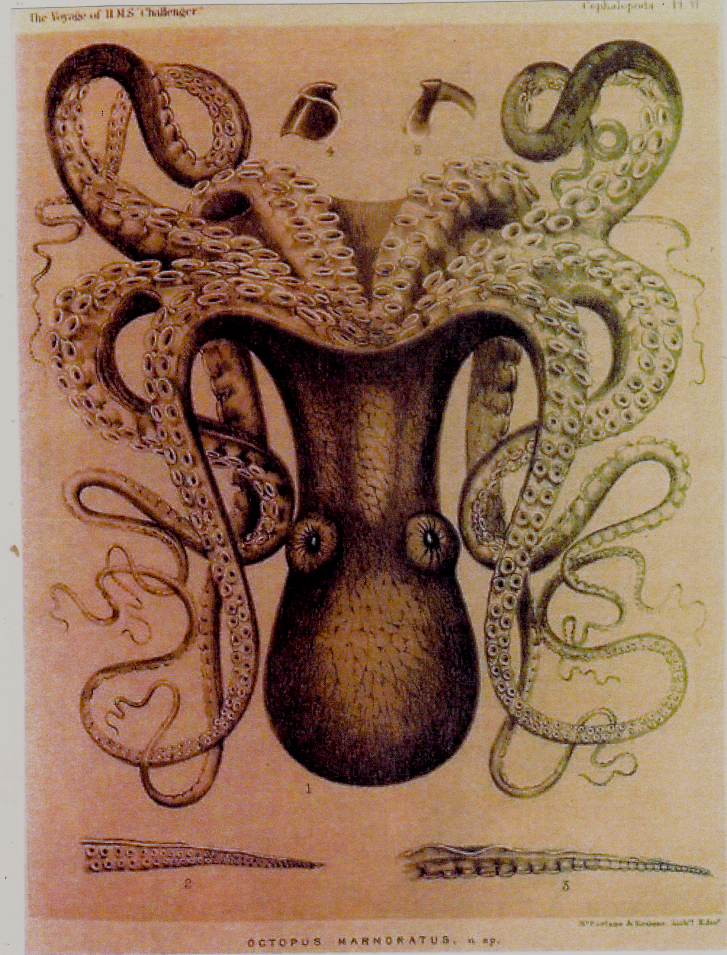
An alien monster from the deep! Sir John Murray commissioned William Evans Hoyle to document illustrate Challenger reports on cephalopods. Like so many other biomedical experts, Hoyle was a superb artist, as can be seen in his work above, from part of vol. 16 (1886) of the reports.
Those of us interested in ocean sounding microscopy often forget there was much more than dredging involved - the only Challenger volume in my own library, for instance, concerns comparative anatomy of skulls. Horsnaill would have delighted in samples from creatures like that cephalopod: I know of none, but it’s possible some may one day turn up among his mounts. Two more Horsnaill mounts of oceanic material are illustrated below.
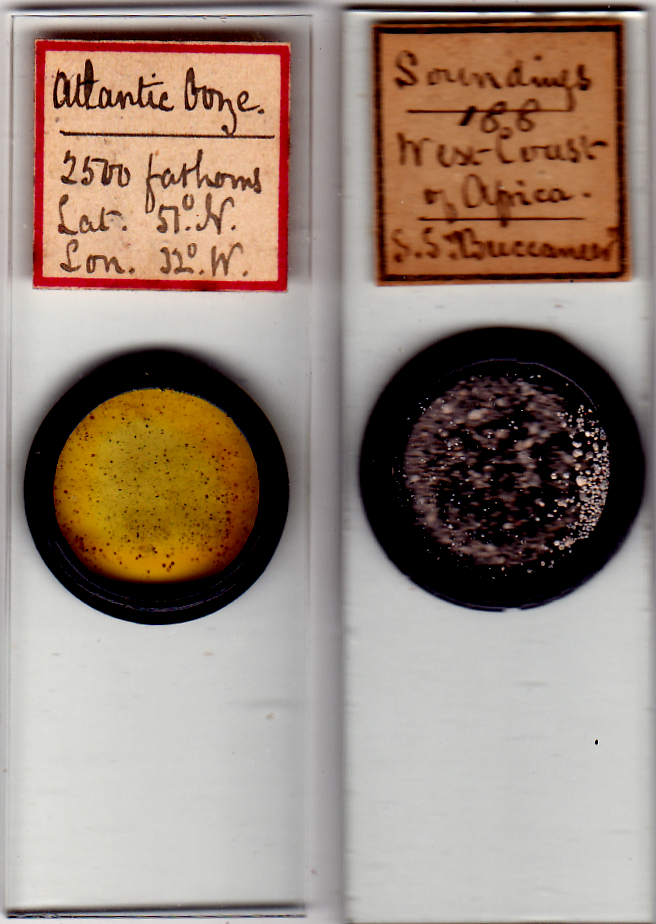
On the left is probable Challenger sampling: dozens, perhaps hundreds of preparers made mounts from Challenger samples, and the practice continues today by those who re-mount material from old slides, attaching their own labels to the results. On the right, I show soundings from S.S. Buccaneer, which was owned by the London Gutta Percha Company. Buccanneer mounts appear rarely in sales these days, and my own collection only has one other, as shown below.
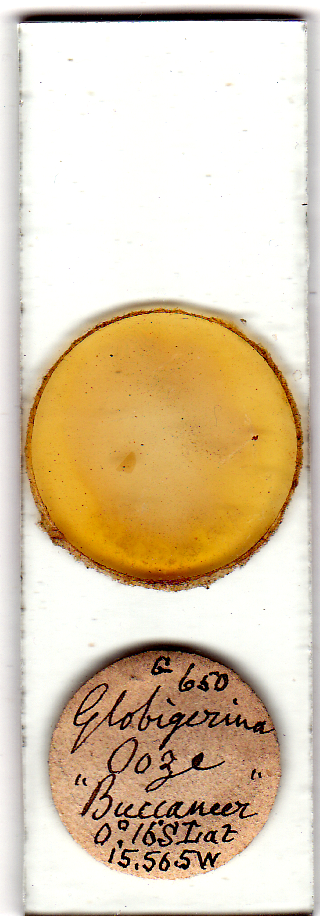
I cannot tell who made that ooze mount, but it seems to come from a large series (at least 650, as indicated) which, given the carefully accurate ship’s position shown, suggests it was made by one of the scientific crew. There are two possibilities – John Rattray and James Young Buchanan. Only Buchanan, the chief chemist on the Challenger, was on both vessels. I have no examples of either’s handwriting, so I cannot speculate further. It’s possible Horsnaill got material from them, but I rather doubt it. Such luminaries were unlikely to respond to (or even notice) Horsnaill’s few Science Gossip exchange advertisements, which in any case did not seek ocean voyage material.
Another (slight) possibility exists: Sir John Murray supplied Challenger material to some collectors.

The Bath address is clear, but I have never deciphered the owner’s name (perhaps a reader may clarify that). Once again, however, I find it somewhat unlikely that Sir John Murray gave material to Horsnaill. So, who were his sources for deep oceanic specimens?
Other Mounters
One mounter – “Greenpapers” (whose identity remains unknown) - was especially prolific with soundings material. That he sold commercially is amply evidenced by many mounts with secondary retail stickers. The large volume of mounts which has continued to sell at internet auctions like ebay, and in particular very many Challenger specimens, tempts one to think “Greenpapers” had a close relationship with someone on the expedition. Often, such mounts are precisely labelled.
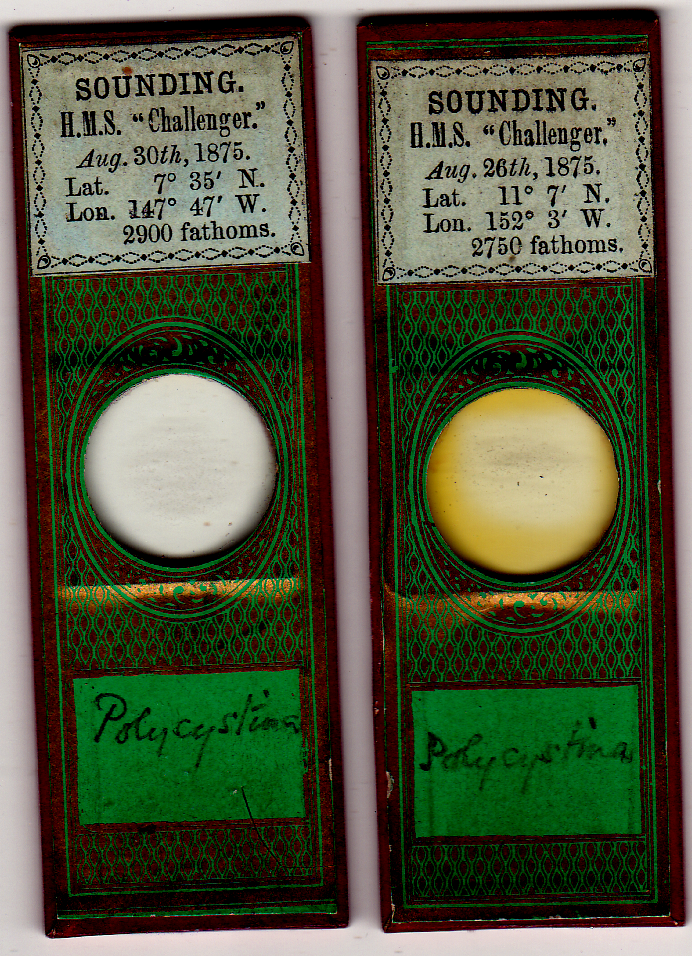
“Polycystina” is written on the papers above, I think, by an owner. “Greenpapers” made so many Challanger mounts that I suspect he had a supply “inside track”, and may have shared or on-sold material to other mounters such as Horsnaill (which – unfortunately - gets us no closer to uncovering the “Greenpapers” identity.) Other large scale commercial mounters featured deep ocean soundings, beginning with Atlantic cable dredging and continuing with samples from the Porcupine and Challenger voyages: I think, but cannot prove, that my collection contains a few mounts from the earlier Lightning voyage. (That last category has never, to my knowledge, turned up at auction firmly accredited.)
Again, the prolific Topping firm, for example, prepared many deep oceanic dredge mounts, including material from cable laying ships, as well as the Challenger expedition: they could have on-sold material via Amos Topping, whose career overlapped substantially with that of Horsnaill.
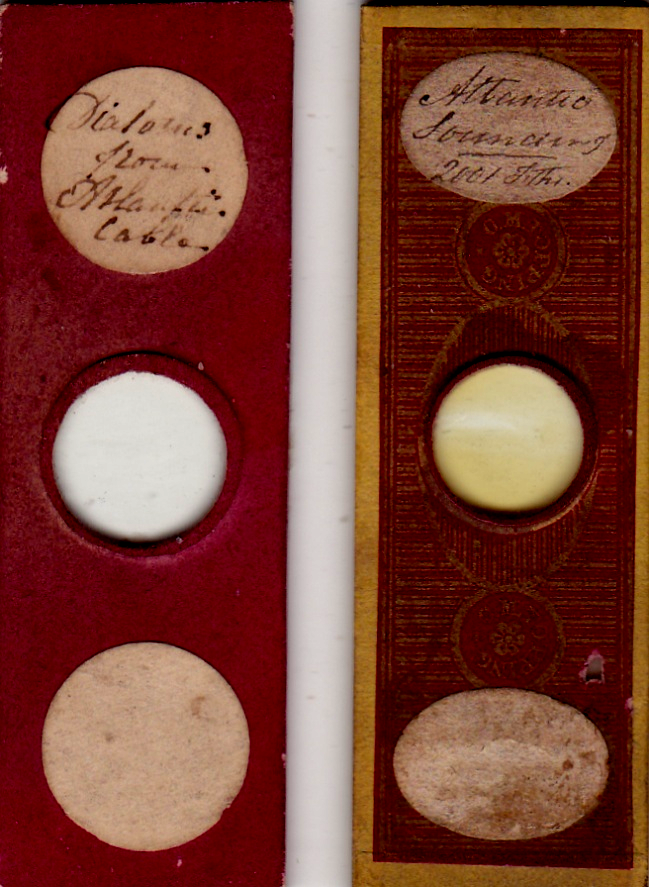
The Topping mount (L) is from an Atlantic cable: that on the (R), with the more familiar Topping label, may be too.
But I believe there was a far more likely supplier to Horsnaill than any suggested so far above.
The Wheeler firm
Horsnaill and Edmund Wheeler were closely related Quakers. It’s been said that the Wheeler mounting family included the daughters: it certainly employed both Frederick Enock and Ernest Hinton, the latter mounting prolifically both before and well after Edmund Wheeler’s death in 1884. Enock’s interests lay almost entirely with insects: Horsnaill mounted some, and it is tempting to think that he may have received some specimens from Enock. Brian Stevenson’s article shows an ixodes from South Africa by Horsnaill, possibly supplied by Enock, and quite likely that insect was captured by one of the Challenger expedition’s frequent forays inland. Notably, the Wheeler firm was in the forefront for mounts from deep sea soundings. The date, 1856, on a slide presently shown below marks it as dredging from Canadian waters: even before the first cable there was laid by the Propontis, preparatory soundings were made by the American ship the Arctic to clarify ocean floor topography. Dredging became a major British Admiralty policy, whether or not the ships laid cable. This was boom time on both sides of the Atlantic for interest in microscopy, and hundreds of clubs were springing up all over Britain, as well as courses offered by Mechanics Institutes and the like. Widespread public interest focussed on prospects of faster communication, but also on what microscopy revealed from the ocean floor, dramatic evidence of which appeared in woodcuts from the Ilustrated London News of December 6 1856, below.
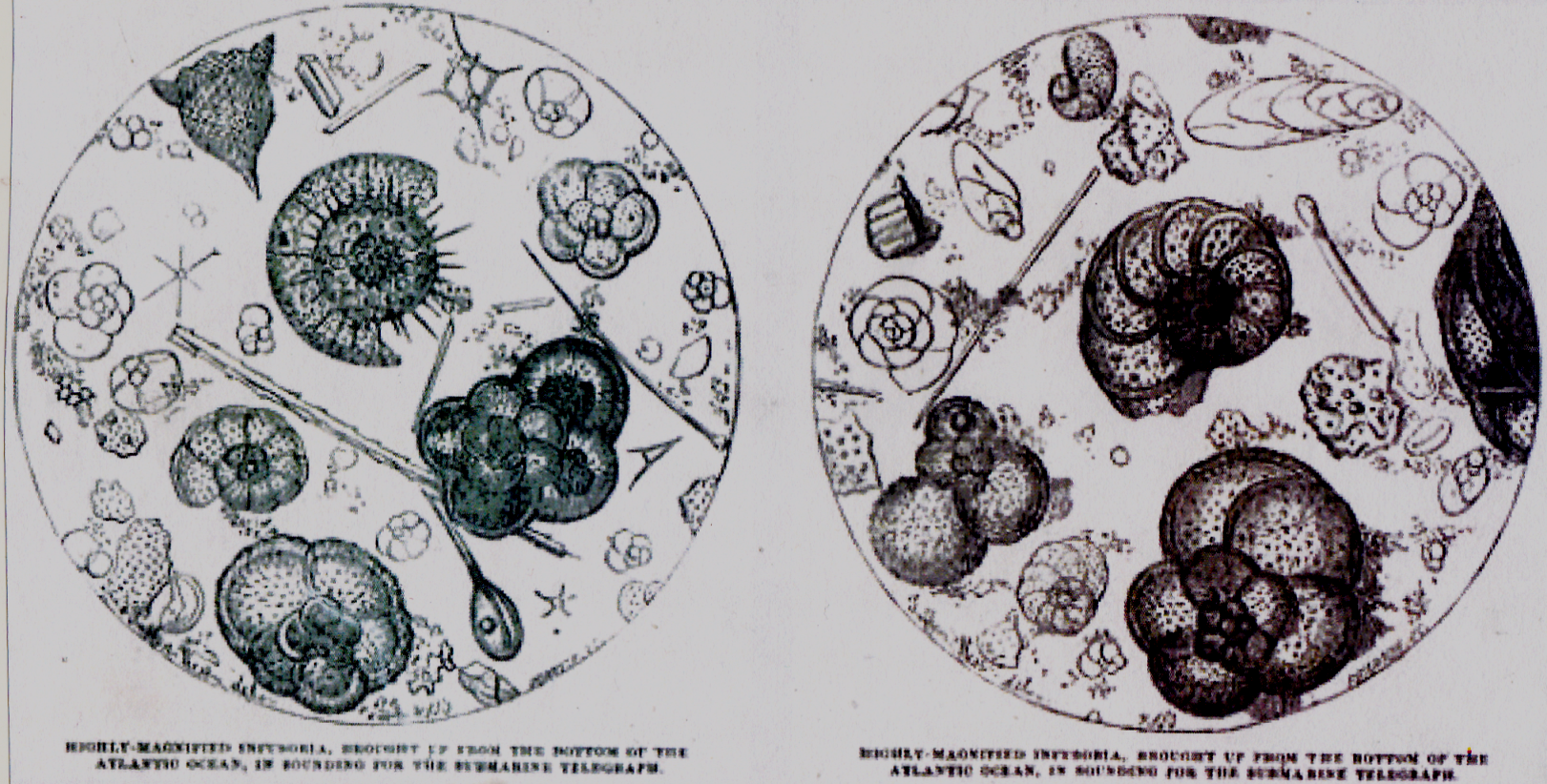
These published illustrations were of microscopy from the American oceanographic ship Arctic, but I do not know who made the mounts. I show them at about the size as they appeared in the periodical. Given that the Crimean War had not long finished, and that the ILN had strongly supported it, it is remarkable that these “infusoria” took up more newsprint space than many Crimean war illustrations published by it earlier in the same year. So, it is unsurprising that Edmund Wheeler was very much alive to the commercial value of dredge mounts. The material below, dated 1856, presumably originated from the Propontis or the Arctic.
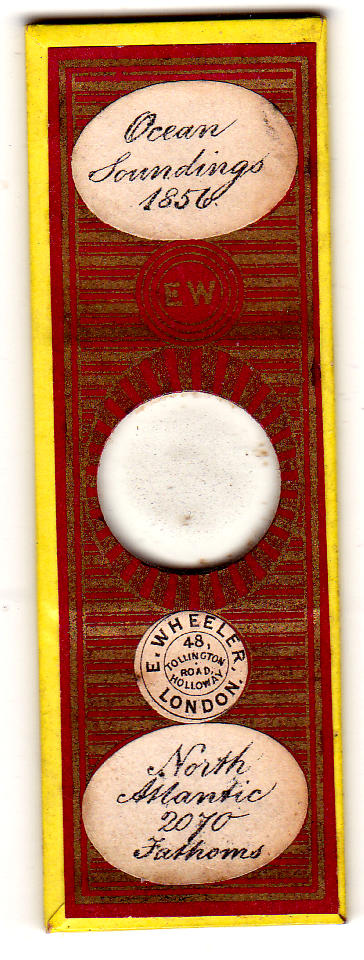
By 1858/9, laying of Mediterranean and Red Sea cables was well advanced and Wheeler once again cashed in on the interests of microscopists (as, in a big way, did “Greenpapers”).
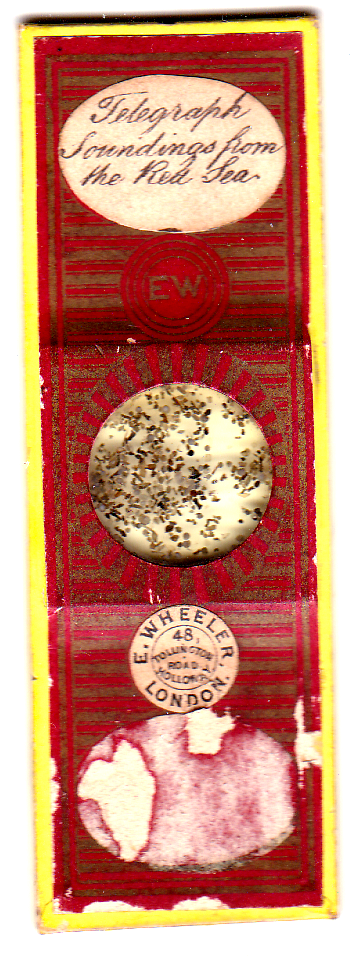
A Wheeler mount from Red Sea telegraph dredging. Unhappily, the lower label has been lost, and it might have contained more information, including the date.
Given their family relationship, the Wheeler firm may well have given Horsnaill material for his oceanic mounts, or put him in touch with its own suppliers. Edmund Wheeler’s connections at the highest scientific level are exemplified by the mount shown below.
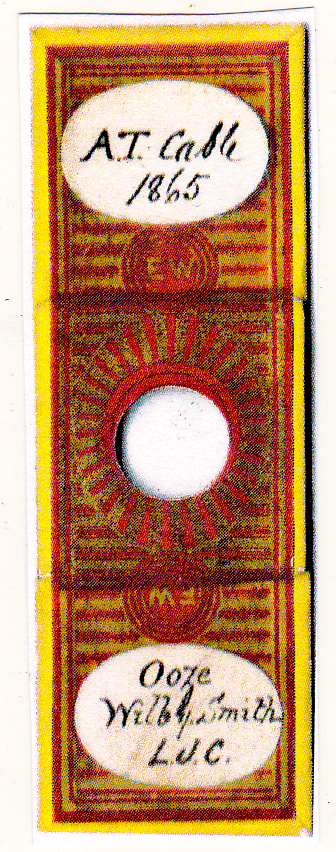
This, surely, is a “smoking gun” demonstrating Wheeler’s contacts at the highest levels. The mount belonged to Willoughby Smith, and probably originated with material supplied by him. Smith, who worked for the London Gutta Percha Company, designed the cables used by all countries, which therefore depended on him for specifications and supplies: as a “spin off”, England dominated undersea cable communication the world over. (The handwriting on its labels, though sparse, may lead to identifying as yet unascribed ocean floor mounts.) I have been unable to interpret “L U. C.” – the “U.C.” I assume refers to “undersea cable”, and the “L” may refer to London cable ship loadings, plenty of illustrations of which appeared in the press. Through Smith, the Wheeler firm could have gained access to any number of cable soundings, like that from the Red Sea already illustrated in this article.
Cable insulation was only one use for gutta percha: in the 1850s, vast amounts were imported from Malaya to the UK, and its uses ranged from jewellery mounting to tennis shoe making to furniture making, with all manner of purposes between. (Given widespread public familiarity with its products, I find it surprising that mounts of the wood whence it was extracted seem to turn up rarely, compared to the profusion of similarly styled mounts of other timbers which continue to surface at auction today.)
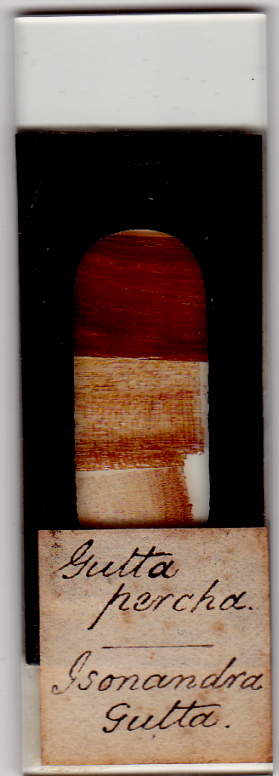
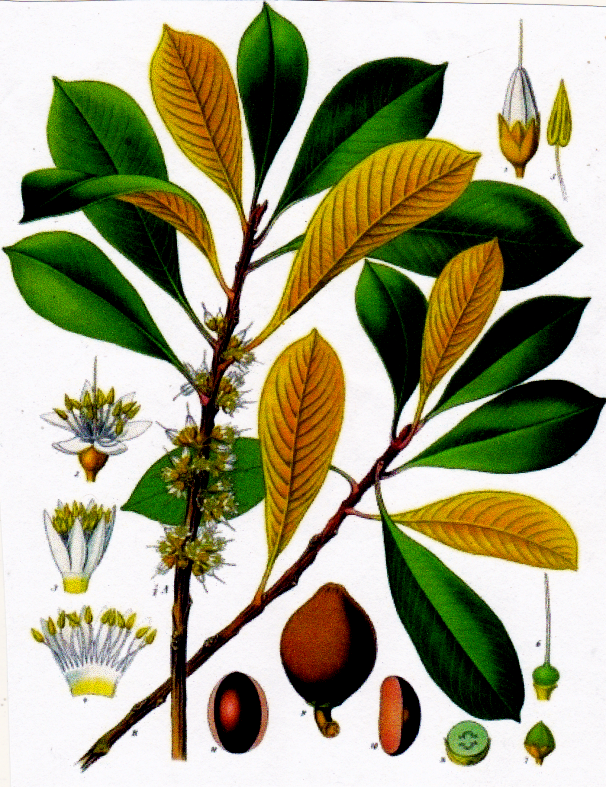
A typical 3-way wood section from around 1850, or perhaps a little earlier (I have not identified the mounter) with (R) palaquium gutta, the principal source of sap from which gutta percha was made
The likely “go-between”
I think the likeliest case for a link between the Wheeler firm and Horsnaill can be proposed for Ernest Hinton. He is thought to have produced a large percentage of Wheeler’s mounts while still working within the firm, and after Edmund Wheeler’s death he continued in business on his own – judging by his many advertisements, more prolifically than ever. His career substantially overlapped that of Horsnaill, and like so many mounters, both commercial and amateur, he made many mounts from Challenger material. Much “Wheeler” oceanic material may have been mounted by Hinton, who after Edmund’s death was still issuing Challenger mounts, either with his own labels, or for example for Baker, whose labels often carry Hinton’s distinctive handwriting.
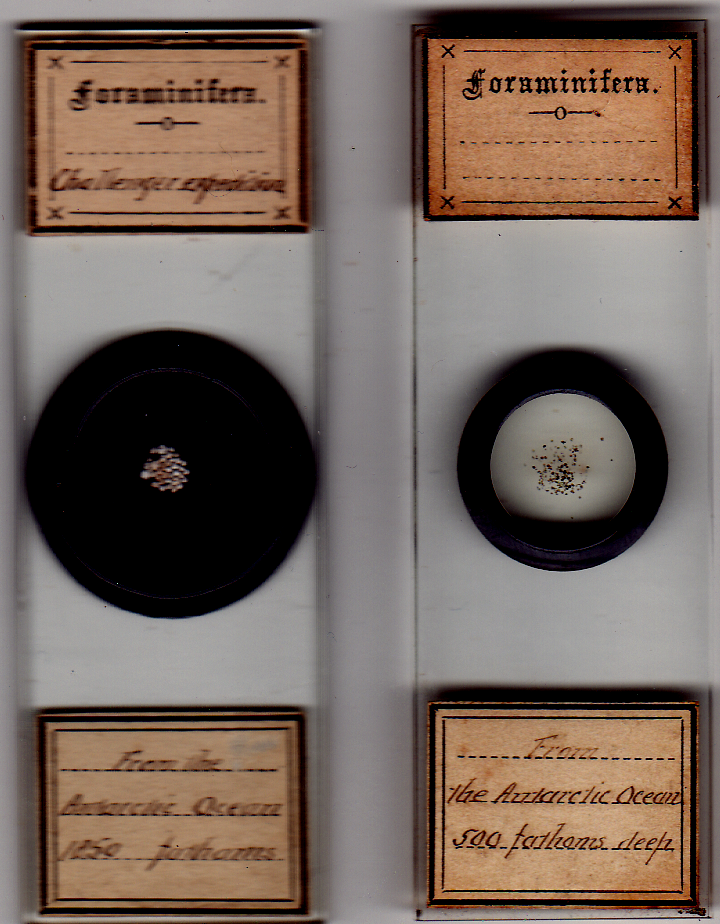
Challenger Antarctic specimens adorn these late Hinton mounts: from their label style, and comparing them with others in my collection, I date them to the 1890s, when Hinton was in business on his own, contemporaneous with Horsnaill’s activities.
Envoi
Much in this article is speculative, but based on a solid evidential core. Notably, Horsnaill’s marine mounts used materials from thousands of miles beyond the east Kent shores: and this article demonstrates that his subject matter, generally, ranged much more widely than is commonly supposed. Given his Wheeler family connections, and some examples in this article, it would be not at all surprising if Horsnaill mounted cable dredge material. The fact that his mounts often carried no personal identifying labels leads me to suspect that many unrecognised slides must be lurking in collections (perhaps among some of my own unsorted specimens!) One final curiosity is that labels printed “Horsnaill Folkestone” do not seem to occur: but some may yet turn up.
I hope I have stimulated Micscape readers to re-examine their cabinets. Given his connection with the Wheeler firm, hence presumably access to much deep oceanic material, we may yet find Horsnaill mounts featuring things from as far away as Australia, and beyond.
Acknowledgements
Many thanks to Bill Burns for helpful comments, and in particular information about Willoughby Smith.
Thanks to Peter Hodds for locating some Horsnaill mounts.
Sources
Except as specified below, all mounts used come from my own collection
Challenger reports, vol.16 (1886)
Wikipedia
www.microscopist.net for Brian Stevenson’s biographical details on Horsnaill, and some further images.
Microscopical Mounts and Mounters (1998 edition) for the fin whale mount illustration.
Contact the author Peter Paisley, email – lois737 AT bigpond DOT com
(Email in anti-spam format, remove spaces, replace capital lletters with the appropriate character and copy / paste to email software.)
Microscopy UK Front
Page
Micscape
Magazine
Article
Library
Published in the April 2017 edition of Micscape Magazine.
Please report any Web problems or offer general comments to the Micscape Editor .
Micscape is the on-line monthly magazine of the Microscopy UK website at Microscopy-UK .
©
Onview.net Ltd, Microscopy-UK, and all contributors 1995
onwards. All rights reserved.
Main site is at
www.microscopy-uk.org.uk .